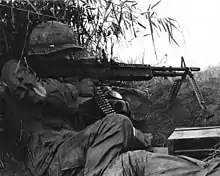Battle of An Ninh
The Battle of An Ninh took place from 18–19 September 1965 between elements of the People's Army of Vietnam (PAVN) 94th and 95th Battalions, 2nd Regiment, 3rd Division and the U.S. 2nd Battalion, 502nd Infantry Regiment and Army of the Republic of Vietnam (ARVN) Rangers.[1] It occurred during an operation codenamed Operation Gibraltar, developed by MACV to clear the area around the 1st Cavalry Division's base at An Khe, South Vietnam.
| Battle of An Ninh | |||||||
|---|---|---|---|---|---|---|---|
| Part of Vietnam War | |||||||
 Sergeant of 502nd Infantry firing an M60 machine gun | |||||||
| |||||||
| Belligerents | |||||||
|
|
| ||||||
| Commanders and leaders | |||||||
| Lt Col W.K.G. Smith | |||||||
| Strength | |||||||
|
| 2nd Regiment, 3rd Division | ||||||
| Casualties and losses | |||||||
|
| US body count: 226–257 killed | ||||||
Battle
Around 07:00, after preliminary airstrikes, the first wave of helicopters dropped 224 men of the 2/502nd Infantryand a company of ARVN Rangers in a landing zone near the village of An Ninh, 30 km east of An Khê.[2]:41–3
Unknown to the U.S./ARVN forces they had landed in the middle of a PAVN training base. When the second wave of helicopters arrived at the landing zone, the PAVN started an intense fire forcing the commander, Lt. Col. W.K.G. Smith to call back the second wave without dropping the soldiers.[2]
The lack of artillery support posed dire difficulties for the American defence perimeter. Air support was initially unavailable due to contaminated fuel supply at Bien Hoa Air Base and it was only shortly after 09:00 that requests for air support were answered with the first mission flown by F-100 fighter-bombers.[2] Air support was the only help available on the first day of combat, with 50 close air support missions flown by dusk, hitting targets as close as 100 m from the defence perimeter, causing two casualties from friendly fire.[2] The continuous effort to reinforce the besieged troops and evacuate the wounded, under enemy fire, involved 26 helicopters.[2]
In the afternoon a U.S./ARVN relief force was transported to a landing zone, not far from the area of the battle, but before they could regroup and start to advance, night fell, and they had to stop.[2] By the time the relief force arrived, the PAVN had already retreated.[3]
Aftermath
U.S. casualties were 13 dead and 28 wounded, for the PAVN, a body count conducted after the battle by U.S. troops claimed around 226 to 257 dead, most of them killed by air bombardment.[2] A total of 11,000 artillery rounds and 100 tactical air-strikes were conducted to avert the potential disaster that awaited US forces[4]
It was the first serious firefight between regular forces of the U.S. Army and the PAVN. The battle was covered by CBS News reporter John Laurence who interviewed the brigade commander, Colonel James Timothy, and paratroopers who had been in the fight. One said their boots were falling apart in the tropical climate and they had eaten corn from the fields because they were out of food. "I was like a proud papa out there," an older sergeant said. "The privates led the charge. The privates went first." "It was a nightmare," a private said. "Nobody slept all night." A sergeant said, "I spent three years in Korea and never saw nothing like this." Laurence witnessed the violent interrogation of an enemy prisoner who had been captured during the battle.[5]
The outcome of the battle was interpreted in different ways; General Westmoreland greeted it as a great victory for the U.S. Army.[2] Others, such as David Hackworth[1] and Maj. J.C.W. Dyke of the 101st Airborne Division considered the battle a tactical and strategic disaster.[2] Dyke regarded the operation as an "ill-conceived plan", which was illustrated by the slow disposition of forces due to the lack of helicopters,[2] while Hackworth commented that "the VC saved the day by walking away".[1]
References
- Hackworth, David H.; Sherman, Julie (15 April 1990). About Face: The Odyssey of an American Warrior. Simon and Schuster. p. 468. ISBN 9780671695347. Retrieved 30 April 2015.
- Carland, John M. (August 2000). Combat Operations: Stemming the Tide, May 1965 to October 1966. Center of Military History United States Army. ISBN 9780160501975.
 This article incorporates text from this source, which is in the public domain.
This article incorporates text from this source, which is in the public domain. - Stanton, Shelby (1995). The Rise and Fall of an American Army: U.S. Ground Forces in Vietnam, 1965-1973.
- Clodfelter, Micheal (13 May 2016). Mad Minutes and Vietnam Months: A Soldier's Memoir. McFarland. ISBN 9780786487561.
- Laurence, John (2002). The Cat from Hue: a Vietnam War Story. PublicAffairs Press. pp. 126–132. ISBN 1586481606.
